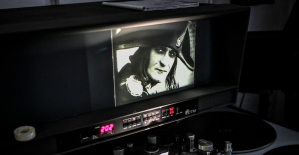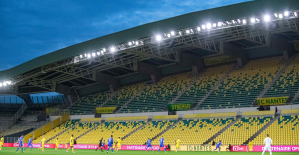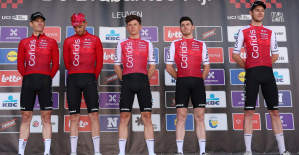It is no exaggeration to say that the Chilean seventy is an important part of the story of modern Sweden. A country's history is never strictly national, and the military coup in Santiago in september 1973 put by the thousands of refugees who came to Sweden a strong imprint not only politically, but also socially and culturally. The chilean resistance low"), echoed in the förstamajtågens slogans, disrupted the Davis Cuptennisens clay courts and was all the way in on the nobel day.
Something of this is visible – fixed from a reverse perspective – Claudia del Fierro's video installation ”El Complejo – the guerrillas, the memory” at the art hall in Lund. This is the story of forestry in central Chile during the Allenderegeringen was taken over by the workers and then become a base for the communist motståndsgerillan MIR. One of the driving forces in the cooperative are still living in Tensta, it turns out. Among the interviewed there is also a Swedish lumberjack who went down that counselor and after the coup ended up in prison where he was tortured.
Claudia Del Fierro, ”Fast forward(travel diary)”, 2-channel video. Photo: Daniel Zachrisson”To remember it is” reflects a group of young chilean artists – most not even born when the coup took place – to the society which has taken shape out of the Allendeårens social upheaval, and the subsequent military repression.
A recurring reference, both artistically and politically it is filmboom that under the name of Nuevo Cine Chileno in the seventies created a wave of documentary and realistic, committed film. The movement had no discernible centre, proclaimed no manifest, but was clearly loyal to the socialist government's program and saw themselves as a cultural point in its emancipations and omdaningsprojekt.
A number of these films are shown in the monitors on the plaza: the tens filmtimmar by directors like Raúl Ruiz, Miguel Littín and Patricio Guzmán, whose nervy, impertinent documentary ”La batalla de Chile”, incidentally, was smuggled out via the Swedish embassy and was completed in Stockholm.
explicitly refers to these predecessors, among them Ivo Vidal, who borrowed the title to his rickety arkitekturmodell from the first part of the Guzmáns documentary trilogy, ”La insurrección de la burguesía” (Burghers ' rebellion). With Vidal, it becomes the ironic title of the story of an outdoor swimming pool in Santiago, which was erected by the socialist government, but following the coup was taken over by the fascists as a symbolic gathering place.
the More ambiguous becomes the writing of history in Sebastian Calfuqueos ”Welu kumplipe”. The film recreates a short scene from a documentary by Ruiz, recorded during His visit to the mapuche community in connection with a new law that would guarantee their land rights. The original translation from the mapuzungún to the Spanish had, however, omitted the critical replica – which means ”he should keep what he promised us.”
a Still image from Sebastián Calfuqueos video ”He should keep what he promised us,” in 2018. Photo: Daniel Zachrissonin this exhibition it is precisely the implied recognition of the risks when the culture is made into a political tool. And how at the same time, the idea of an apolitical art must remain an illusion. From Leonardo Portus arkitektursociologiska observations to Enrique Ramirez brechtska verfremdungseffekter in the poetic ”Brisas” is permeated by the intricate thoughts on how art and politics at once presupposes and push each other away.
a Pity only that the show does not really hold together. It all feels in an unfortunate way, both overloaded and minimalist – with a myriad of details and facts, but very little that detangles and binds them together. Even visually it gives it a chaotic and fragmented impressions, especially in samtidskonstdelen where to and with the spatial transitions between the different works are sometimes unclear.
a Still image from ”Shakalen from Nahueltoro” by Miguel Littín, 1969. Photo: Miguel LittínIt is instead the cinematographic reference material on the upper which will be the major benefits. This is on the other hand, how much time to download – Littíns cutting-edge ”El chakal de Nahueltoro”, Guzmáns classic documentary of course, and I wonder just when Raúl Ruiz got his films shown in Sweden last...
A cultural deed, just it.

 Iran-Israel conflict: what we know about the events of the night after the explosions in Isfahan
Iran-Israel conflict: what we know about the events of the night after the explosions in Isfahan Sydney: Assyrian bishop stabbed, conservative TikToker outspoken on Islam
Sydney: Assyrian bishop stabbed, conservative TikToker outspoken on Islam Torrential rains in Dubai: “The event is so intense that we cannot find analogues in our databases”
Torrential rains in Dubai: “The event is so intense that we cannot find analogues in our databases” Rishi Sunak wants a tobacco-free UK
Rishi Sunak wants a tobacco-free UK Alert on the return of whooping cough, a dangerous respiratory infection for babies
Alert on the return of whooping cough, a dangerous respiratory infection for babies Can relaxation, sophrology and meditation help with insomnia?
Can relaxation, sophrology and meditation help with insomnia? WHO concerned about spread of H5N1 avian flu to new species, including humans
WHO concerned about spread of H5N1 avian flu to new species, including humans New generation mosquito nets prove much more effective against malaria
New generation mosquito nets prove much more effective against malaria The A13 motorway closed in both directions for an “indefinite period” between Paris and Normandy
The A13 motorway closed in both directions for an “indefinite period” between Paris and Normandy The commitment to reduce taxes of 2 billion euros for households “will be kept”, assures Gabriel Attal
The commitment to reduce taxes of 2 billion euros for households “will be kept”, assures Gabriel Attal Unemployment insurance: Gabriel Attal leans more towards a tightening of affiliation conditions
Unemployment insurance: Gabriel Attal leans more towards a tightening of affiliation conditions “Shrinkflation”: soon posters on shelves to alert consumers
“Shrinkflation”: soon posters on shelves to alert consumers The restored first part of Abel Gance's Napoléon presented at Cannes Classics
The restored first part of Abel Gance's Napoléon presented at Cannes Classics Sting and Deep Purple once again on the bill at the next Montreux Jazz Festival
Sting and Deep Purple once again on the bill at the next Montreux Jazz Festival Rachida Dati: one hundred days of Culture on the credo of anti-elitism
Rachida Dati: one hundred days of Culture on the credo of anti-elitism The unbearable wait for Marlène Schiappa’s next masterpiece
The unbearable wait for Marlène Schiappa’s next masterpiece Skoda Kodiaq 2024: a 'beast' plug-in hybrid SUV
Skoda Kodiaq 2024: a 'beast' plug-in hybrid SUV Tesla launches a new Model Y with 600 km of autonomy at a "more accessible price"
Tesla launches a new Model Y with 600 km of autonomy at a "more accessible price" The 10 best-selling cars in March 2024 in Spain: sales fall due to Easter
The 10 best-selling cars in March 2024 in Spain: sales fall due to Easter A private jet company buys more than 100 flying cars
A private jet company buys more than 100 flying cars This is how housing prices have changed in Spain in the last decade
This is how housing prices have changed in Spain in the last decade The home mortgage firm drops 10% in January and interest soars to 3.46%
The home mortgage firm drops 10% in January and interest soars to 3.46% The jewel of the Rocío de Nagüeles urbanization: a dream villa in Marbella
The jewel of the Rocío de Nagüeles urbanization: a dream villa in Marbella Rental prices grow by 7.3% in February: where does it go up and where does it go down?
Rental prices grow by 7.3% in February: where does it go up and where does it go down? With the promise of a “real burst of authority”, Gabriel Attal provokes the ire of the opposition
With the promise of a “real burst of authority”, Gabriel Attal provokes the ire of the opposition Europeans: the schedule of debates to follow between now and June 9
Europeans: the schedule of debates to follow between now and June 9 Europeans: “In France, there is a left and there is a right,” assures Bellamy
Europeans: “In France, there is a left and there is a right,” assures Bellamy During the night of the economy, the right points out the budgetary flaws of the macronie
During the night of the economy, the right points out the budgetary flaws of the macronie These French cities that will boycott the World Cup in Qatar
These French cities that will boycott the World Cup in Qatar Champions League: France out of the race for 5th qualifying place
Champions League: France out of the race for 5th qualifying place Ligue 1: at what time and on which channel to watch Nantes-Rennes?
Ligue 1: at what time and on which channel to watch Nantes-Rennes? Marseille-Benfica: 2.99 million viewers watching OM’s victory on M6
Marseille-Benfica: 2.99 million viewers watching OM’s victory on M6 Cycling: Cofidis continues its professional adventure until 2028
Cycling: Cofidis continues its professional adventure until 2028


















